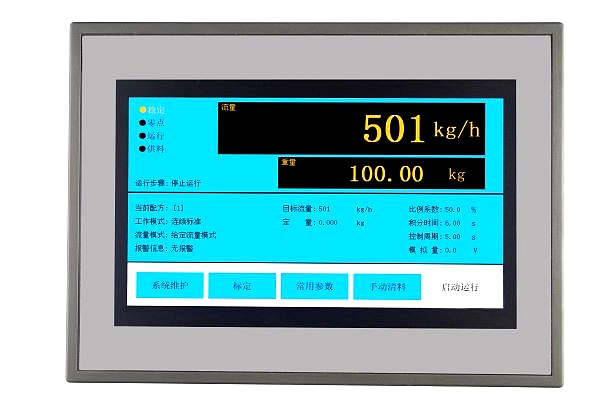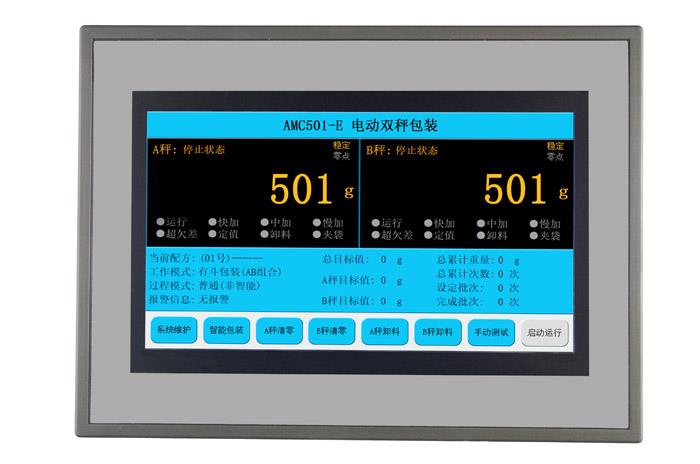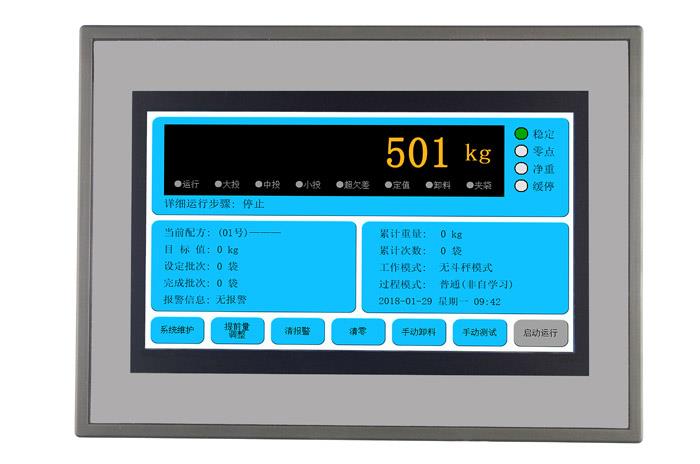
2020-03-08
The loss-in-weight scale instrument is a quantitative feeding device that uses the material reduction per unit time to calculate the material flow. It converts the weight of the material in the silo into a voltage signal through the load sensor installed on the silo. The signal (mV) The analog input channel AD port of the continuous loss-in-weight scale instrument is input to the instrument. After calculation, the lost weight of the silo in unit time, that is, the instantaneous flow rate. When there is an error between the instantaneous flow rate and the set value, the DA output of the instrument can be adjusted to adjust the output. Change the cutting speed until the error is zero.
The weightless scale instrument can set common parameters in the weighing process and can view the type number, the actual weight of the previous scale and various accumulations;
●It has control functions such as feeding, 2-level or 3-level feeding, bag clamping, bag shooting and batch setting control; the spare output port can choose various output functions at will;
●It can store the reliable parameters after debugging and restore the factory parameters; 26 channels of digital input and output and one channel of analog output, and the communication can choose RS232 or RS485 output;
The weightless scale instrument adopts multiple filtering technologies, the input and output interface adopts photoelectric isolation, RC filtering, transient voltage controller overvoltage maintenance and other hardware anti-interference technologies, as well as digital filtering, data verification and watchdog reset, etc. Software anti-interference measures.
●The communication of the weightless scale instrument adopts the international conventional MODBUS protocol, which can be easily connected with the touch screen, PLC, upper computer and large screen.
●The instrument of the continuous weightless scale adopts the field bus technology to conveniently complete the multi-point control, expand the data acquisition interface beside the machine and communicate with the upper computer, and truly complete the digitization of the system.
●High-speed industrial-grade processor can ensure the real-time performance of the weightless scale instrument under any conditions.

●Using SMT technology, modular high-performance switching power supply, liquid crystal display of Chinese characters, all industrial-grade components, small metal shell.
●All products have undergone 72 hours of high temperature live aging, 2 weeks of imitation operation and electromagnetic compatibility (qualitative) testing before leaving the factory.
The loss-in-weight scale has both static scale and dynamic scale characteristics. Therefore, when designing the system, it is required to:
The correct range of conveying rate of the weightless scale instrument, the general practical working range is 60 percent of the rated conveying amount and 70 percent is the best. If AC speed regulation is used, the best strain frequency is 3540Hz. This ensures a wide range of adjustment, because when the conveying rate is too high When it is low, the system stability is poor. That is to say, the sensor also uses 60% to 70% of its range, and the signal variation range is wide, which is extremely beneficial to improve the accuracy. The feeding time is short, and the feeding should not be too frequent. Generally, it is required to feed once every 510 minutes. The supporting transmission system should ensure smooth operation and good linearity.
With the rapid development of electronic control technology, the weightless scale instrument adopts new technology, from 0.3% to 0.5%, to 0.1% to 0.2%, and even beyond the static scale, the center of this new technology is the digital scale. Applications of heavy sensors.

1 10, 2025

1 10, 2025